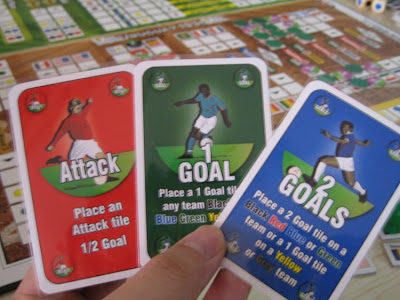The World Cup Game is about the football (UK English speakers) / soccer (US English speakers and Melbournians) world cup. I shall just call it football, since I am a UK English speaker. If you are a football fan, you'll probably like this game. It is very thematic, and it is quite simple. Some knowledge of how football works and how the world cup works will be very helpful in both immersing yourself in the theme and in understanding the rules.
At the start of the game, all players randomly draw a number of teams. Throughout the game, your teams compete and try to advance through each stage of the world cup competition, and try to eventually win the world cup. Just like the real world cup, except you do this in about 35-45 mins, while the real world cup takes about a month.
The game board shows all the matches of the world cup event. Each team in each match has 2 to 5 slots, depending on whether the team is a strong team. Strong teams get more slots. During the game, you have a hand of 3 cards, and you play cards to place round tokens onto the slots on the board. The tokens can represent goals, attacks, defenses, and penalty kicks. Some cards allow you to nullify effects of other tokens played by flipping them over. Teams with more slots have a higher chance of winning, because there are more slots to place goals and attack tokens. Each stage of the competition ends when the draw deck is exhausted. However, the results of the matches are not deterministic. You still need to roll some special dice. For each match, goals count as goals, and attacks count as half a goal (round down). When the dice are rolled for the just-completed stage, every occurrence of your team's colour in the die roll result gives your team an additional half-goal, which can be added to the attack tokens your team has. The colours of the dice are not distributed evenly. Stronger teams have a higher chance of their colours appearing. This is another way the game tries to push towards the historical, or at least a realistic ending.
This may sound like a bad thing, because if you only draw lousy teams, then your hopes of winning the game are dashed. But then I find that I don't really mind it that much. Somehow when playing this game I prefer it to feel real.





I quite enjoyed this game. It was a pleasant surprise. I also learned a few things about the world cup. The world cup rules in 1930 (the year that we played) were actually rather different from the rules in 2002. E.g. in the first round, winning a match earns your team 2pts instead of 3pts. The game comes with two "scenarios", 1930 and 2002. There are many expansions, which are basically the other years the world cup was held. The game doesn't really change all that much, but for a football fan, it would be fun to collect all these expansions, and to re-live so many different world cup finals.
No comments:
Post a Comment